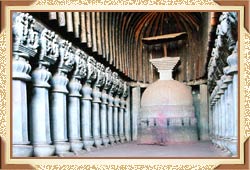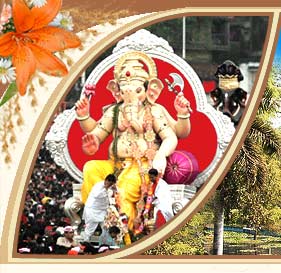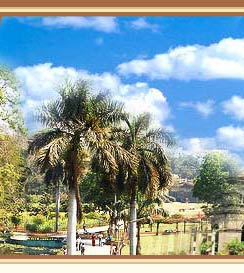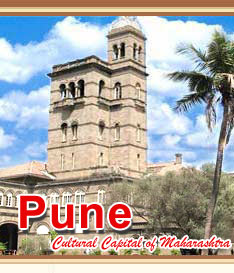
Situated
on the Pune-Mumbai Road, Karla Caves are approximately 40 km away from
the city of Pune. These caves date back to the 2nd century BC and
represent the golden period of Buddhism in India. The major attractions
of the Karla Caves consist of the Chaitya Hall, beautifully chiseled
sculptures and pillars adorned with incredible architecture. The
magnificent structural design of the Chaitya Hall makes it a must see.
Even the rooftop, made up of teakwood, has been exquisitely carved.
One of the pillars of the Karla caves has four lions at the top. This
design has been adopted as the national emblem of India. There are a
number of rock-cut sculptures inside the caves, displaying animals as
well as various forms of human life. There is also a stone stupa, placed
under an umbrella and carved with figures of men, women and elephants.
The 37 pillars chiseled with the figures of prosperous men and women on
elephants, bowing before Lord Buddha, add to the attraction of Karla
caves.
The Karla cave complex comprises of a number of chaityas i.e., prayer
halls, which have been carved with great precision. Then, there are also
a number of viharas, dwelling places for the monks, which have been
similarly ornamented. All these chaityas and viharas date back to the
time of the Hinayana Buddhists and have arched entrances and vaulted
interiors. There are no images of Lord Buddha in the caves, only
symbolical descriptions. The portico of Karla caves is carved in such a
way so as to give it an appearance of finished wood and has a large
horseshoe arch as the central motif.






 Situated
on the Pune-Mumbai Road, Karla Caves are approximately 40 km away from
the city of Pune. These caves date back to the 2nd century BC and
represent the golden period of Buddhism in India. The major attractions
of the Karla Caves consist of the Chaitya Hall, beautifully chiseled
sculptures and pillars adorned with incredible architecture. The
magnificent structural design of the Chaitya Hall makes it a must see.
Even the rooftop, made up of teakwood, has been exquisitely carved.
Situated
on the Pune-Mumbai Road, Karla Caves are approximately 40 km away from
the city of Pune. These caves date back to the 2nd century BC and
represent the golden period of Buddhism in India. The major attractions
of the Karla Caves consist of the Chaitya Hall, beautifully chiseled
sculptures and pillars adorned with incredible architecture. The
magnificent structural design of the Chaitya Hall makes it a must see.
Even the rooftop, made up of teakwood, has been exquisitely carved.